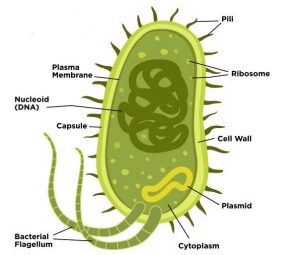What is Kingdom Monera? Definition, Examples, Characteristics
Before delving into the specifics of Kingdom Monera, it’s essential to understand the concept of biological classification. In biology, living organisms are classified into various groups based on their shared characteristics. One such classification system is the five-kingdom classification, which categorizes organisms into Kingdoms: Animalia, Plantae, Fungi, Protista, and Monera.
In this article, we focus on understanding what Kingdom Monera is, its structure, classification, and examples become essential for grasping the basics of the biological world. Let’s dive into the realm of Kingdom Monera to unravel its mysteries.
What is Kingdom Monera?
Kingdom Monera comprises unicellular organisms, primarily bacteria and archaea. Unlike organisms in other kingdoms, Monera lack membrane-bound organelles and a true nucleus, hence they are often referred to as prokaryotes. This kingdom encompasses some of the earliest forms of life on Earth, exhibiting remarkable adaptability and diversity.
Kingdom Monera Diagram
The Kingdom Monera diagram represents a diverse group of unicellular organisms. These organisms lack a nucleus and membrane-bound organelles, making them prokaryotes. They play a crucial role in various ecological processes, showcasing the importance of studying them.

Structure of Kingdom Monera
The structure of Kingdom Monera is relatively simple yet intriguing. Most monerans possess a cell wall made of peptidoglycan, providing structural support and protection. Additionally, they have a plasma membrane, cytoplasm, and genetic material in the form of DNA. These organisms exhibit high adaptability to diverse environments due to their unique structure.
Looks complex? Let’s understand the structure of kingdom monera in simple words.
In other words, Unlike more complex organisms, Monera lacks a distinct nucleus. Instead, it features a simple structure, with a cell wall and a cell membrane. The cell wall provides strength and protection, while the membrane regulates what goes in and out.
Within Kingdom Monera, organisms come in various shapes, such as cocci (spherical), bacilli (rod-shaped), and spirilla (spiral). The simplicity of their structure allows them to adapt and thrive in diverse environments, from the depths of the ocean to the highest mountain peaks.
Monera Kingdom Classification
Within the Kingdom Monera, there are various types classified based on distinctive characteristics. These include:
- Bacteria: These are the most common and well-known monerans. They can be found in various habitats, showcasing a wide range of metabolic capabilities.
- Archaea: Archaea are ancient prokaryotic organisms that thrive in extreme environments such as hot springs and deep-sea vents. They exhibit unique genetic makeup and metabolic pathways.
- Cyanobacteria: Also known as blue-green algae, cyanobacteria are photosynthetic bacteria capable of producing oxygen through photosynthesis. They play a crucial role in the Earth’s ecosystem.
Monera Kingdom Characteristics
The Kingdom Monera is characterized by several key features:
- Unicellular structure
- Prokaryotic cell organization
- Diverse metabolic capabilities
- Presence of cell wall
- Rapid reproduction rates
- Ubiquitous distribution in various environments
Examples of Kingdom Monera
Now, let’s meet some of the notable inhabitants of Kingdom Monera. These examples demonstrate the diversity within this kingdom:
- Escherichia coli (E. coli): Found in the human gut, E. coli serves various metabolic functions and is commonly used in biological research.
- Mycobacterium tuberculosis: The causative agent of tuberculosis, this bacterium showcases the pathogenic nature of certain monerans.
- Synechocystis: A type of cyanobacteria, Synechocystis contributes to oxygen production through photosynthesis.
- Streptococcus pyogenes: Known for causing strep throat and other infections, this bacterium is a significant human pathogen.
- Methanogens: A type of archaea that produces methane as a byproduct of metabolism, playing a crucial role in the carbon cycle.
Final Verdict
In conclusion, Kingdom Monera represents a fascinating and diverse group of organisms essential for understanding the intricacies of the biological world. From their structure and classification to their unique characteristics and examples, delving into the realm of Kingdom Monera opens doors to a deeper appreciation of the complexity of life on Earth. Remember to explore further and discover the wonders of Kingdom Monera, unlocking a world of knowledge waiting to be explored.
This blog post delves into the world of Kingdom Monera, shedding light on its definition, examples, structure, classification, and characteristics. Dive into the realm of Monera and uncover the mysteries of these unicellular organisms.
Eager to easily grasp concepts, as illustrated above? Delve into our Tutoroot Blog section for simplified learning. Deepen your understanding of subjects and get your questions answered through Tutoroot’s online tuition. Immerse yourself in Tutoroot’s online home tuitions today by scheduling a FREE DEMO session.
FAQs
Write 10 examples of kingdom monera
- Escherichia coli
- Mycobacterium tuberculosis
- Synechocystis
- Streptococcus pyogenes
- Methanogens
- Bacillus subtilis
- Chlamydia trachomatis
- Helicobacter pylori
- Vibrio cholerae
- Clostridium botulinum
What are the Types of Kingdom Monera?
The types of Kingdom Monera include bacteria, archaea, and cyanobacteria.
Define Kingdom Monera
Kingdom Monera comprises unicellular prokaryotic organisms with diverse metabolic capabilities, essential for various ecological processes.
